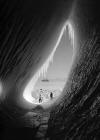|
saLT |
the-south-asian Life & Times April - June 2010 |
|
|||
|
Art Travel Women
& Politics
Profile Comment Future Predictions
|
|
||||
|
Antarctica 100 years ago – and today Compiled by SALT
Herbert Ponting captured the stark beauty of Antarctica 100 years ago, in a series of landscape shots which remain iconic and timeless to this day. June 2010 marks the centenary of Captain Robert Scott's epic voyage to the South Pole. Ponting joined Captain Robert Scott’s Terra Nova expedition (1910-12) to the South Pole, as the first professional photographer or ‘camera artist’ as he preferred to be called. Ponting left Cape Evans in early 1912, along with eight other men for their voyage home, while Scott and some of the team members set off on their long walk to the Pole – never to return.
Herbert Ponting was the pioneer of modern polar photography. He was the
first to bring an artistic eye to the science of recording polar expeditions
and life - in a technically challenging and artistically inspiring part of
the world that he would ever encounter. His work influenced and inspired
other photographers to the Antarctic. Read more in the print edition Recent climate
change has driven significant changes in the physical and living environment
of the Antarctic. Environmental change is most apparent in the Antarctic
Peninsula (AP), where climate change has been largest. Adélie penguins, a
species well adapted to sea ice conditions, have declined in numbers and
been replaced by open-water species such as chinstrap penguins. Melting of
perennial snow and ice covers has resulted in increased colonisation by
plants. A long-term decline in the abundance of Antarctic krill in the SW
Atlantic sector of the southern ocean may be associated with reduced sea ice
cover.
Read more in the
print edition The Antarctic – mankind’s only collective legacy Antarctica has been designated as “a natural reserve, devoted to peace and science”. Scientists and support personnel from 27 nations are involved in research projects across this frozen-continent. India launched its Antarctic Programme in 1981 when it sent its first expedition, a 21-member team, under the leadership of Dr. S. Z. Qasim from the Department of Environment. It was in 1983 that India commissioned its first permanently manned base in the Antarctic - "Dakshin Gangotri". It was set up on an ice shelf off the Princess Astrid Coast (70°45′S 12°30′E) in central Queen Maud Land. Six years later the station had to be abandoned due to excessive snow accumulation, by which time a second research station - Maitri - had already been constructed, almost 90 kilometers away from Dakshin Gangotri, on a rocky mountainous region called Schirmacher Oasis. A new Indian station, named Bharti, is scheduled to be operational by 2012. Read more in the print edition
Subscribe to the print edition - subscribe@the-south-asian.com
|
|||||
|
Copyright © 2000 - 2010 [the-south-asian.com]. Intellectual Property. All rights reserved. |
|||||
